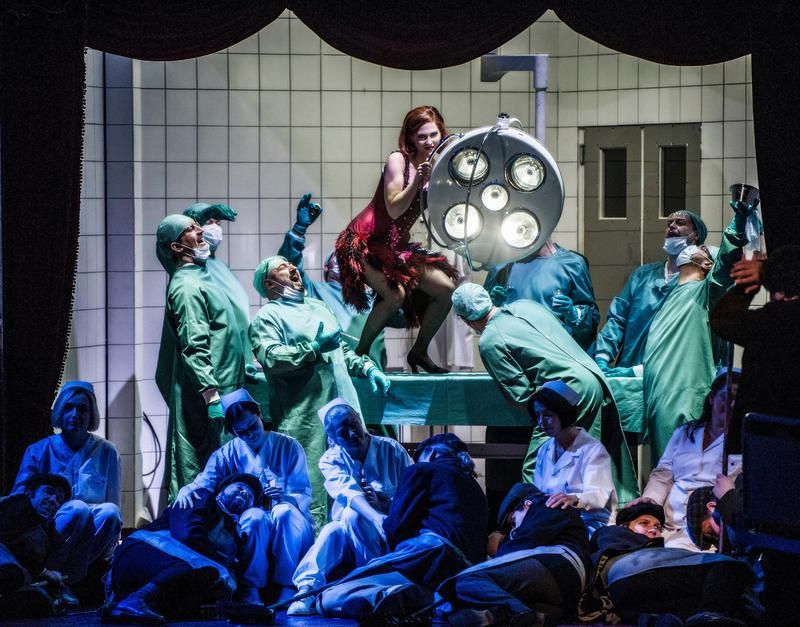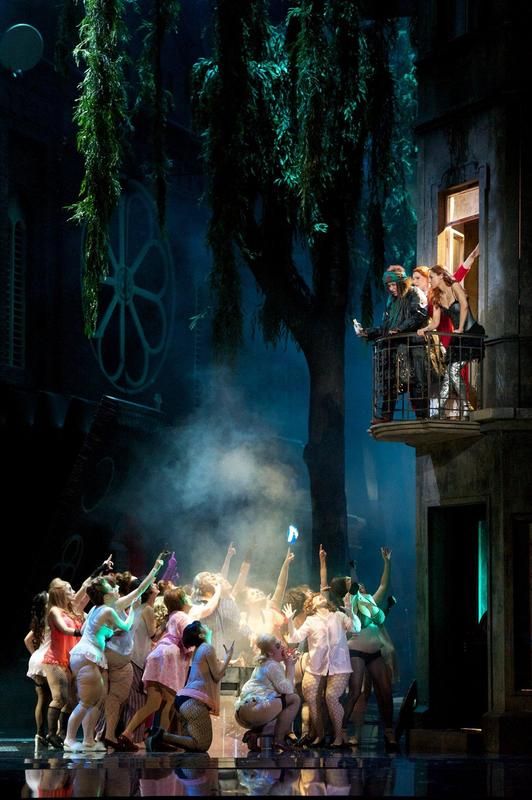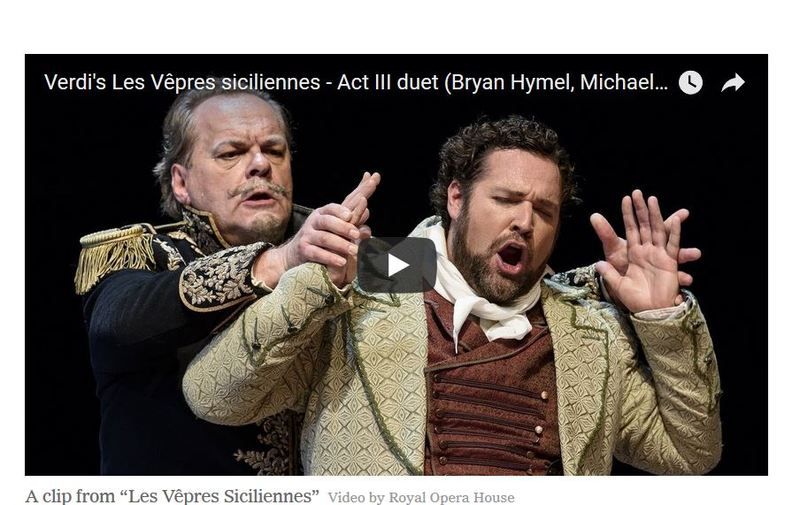Stefan Herheim’s Glittering Collisions Have Changed Opera
By David Allen
June 29, 2018
LEWES, England — Stefan Herheim wants your attention.
When his productions fulfill his visions, the viewers can’t ignore what’s happening, Mr. Herheim, one of opera’s most innovative stage directors, said.
“That’s a feeling I absolutely adore, when the audience doesn’t just lean back and agree, ‘This is lovely, this is beautiful, this is happiness, this is exactly what we expected.’”
What he expects is for them “not to be bored,” he added in an interview after a rehearsal for Debussy’s “Pelléas et Mélisande” at the Glyndebourne Festival here; his much-anticipated staging opened on June 30.
Bored, watching a Herheim show? Never. Dazzled, yes. Bewildered, probably. Over the past 15 years, he has become celebrated for immensely complicated stagings of works we thought we knew, like “La Bohème,” “Parsifal” and “Les Contes d’Hoffmann,” that are both bombastic spectacles and intellectual disquisitions. They’re full of blinding coups de théâtre — but replete, too, with playful minutiae you might see only on your fifth time around. They create glittering collisions between a work, its history and our expectations of it.
“Our idea of how ‘Carmen’ is supposed to look or be sometimes overshadows the piece itself,” he said. “You have to dig into it, and see: Oh, no, actually the tradition is wrong.”
“You have to put yourself in a time machine,” he added, “and travel with the work back in time — and then translate it back.”
Born in Oslo, Mr. Herheim, 48, practically has opera in his blood. As a young boy, he sat at the side of his father, a violist, in the pit at the Norwegian National Opera. At about 6, he started putting on his own productions at home, using puppets.
As he grew, he studied the cello and helped out at the opera house as a production assistant, learning how a company operates behind the scenes. He set up a puppet opera theater that toured Norway. By 1994, he was studying in Hamburg, under the influential director Götz Friedrich. Nine years later, he won a prestigious directing prize named after his teacher.
“Stefan Herheim is the rare stage director who can have his cake and eat it, too,” Peter Gelb, the general manager of the Metropolitan Opera, said in an email. “He meets the demands of the cynics who think the only good stagings are radical ones, while never abandoning his excellent narrative storytelling skills.”
Mr. Gelb added that the Met plans to bring Mr. Herheim’s production of Verdi’s “Les Vêpres Siciliennes,” which originated in London in 2013, to New York in a future season. For a time, it looked as if Mr. Herheim would make his Met debut in 2019-20, with a reprise of a fanciful “Die Meistersinger von Nürnberg” that wowed the Salzburg Festival in 2013.
It was one of several notable Wagner productions that cemented his reputation, most important among them a “Parsifal” at the Bayreuth Festival in 2008. But the Met’s “Meistersinger” was not to be; it was canceled after problems arose in redesigning the sets for the Teatro alla Scala in Milan, another of the producers.
Mr. Herheim is perhaps not a natural fit for the Met. He has an apt taste for extravagance, but Franco Zeffirelli he is not. While his stagings are intensely musical — during “Pelléas” rehearsal, in which he was a busy, perfectionist presence, one was struck by the sheer number of scores in use, by the precision with which the singers’ movements were tied to the sense of the notes — they are vertiginously complex. Mr. Herheim creates a kind of meta-opera, telling multiple stories at once by layering a work’s cultural context and reception history on top of its plot. Much of his artistic philosophy takes aim at opera’s conservative traits — particularly its unquestioning fetish for the past.
“Traditionalists,” Mr. Herheim said, “will say, ‘Why don’t you do it as it was supposed to be?’ Of course, you can do that, but that’s not the point of art. This is music that wants to be transferred, and wants to have an immediate effect on your life.”
“You will always be a child of your time; you can never escape that,” he added. “I feel like I am serving the score, and trying, together with everyone involved” — he has a team of frequent collaborators, including the dramaturge Alexander Meier-Dörzenbach — “to recompose it, to make it hearable to us so that we can make it hearable to others.”
Mr. Herheim has several tricks up his sleeve to “revive” or “rewrite” operas, as he puts it, for eyes and ears deadened by modern life. One is to make a work’s history visible. Often an opera’s composer will appear as a character, as Offenbach did in “Les Contes d’Hoffmann” (the Bregenz Festival in Austria in 2015) and Tchaikovsky in “Pique Dame” (Amsterdam, 2016). “Les Vêpres Siciliennes” was set among the musicians and dancers at that work’s original premiere at the Paris Opéra in 1855, to show how sex, politics and music inevitably collide.
Then there are productions that toy with what we think we know about the past. Handel’s “Xerxes,” for the Komische Oper in Berlin in 2012, parodied contemporary approaches to the Baroque. In Wagner’s “Tannhäuser” in Oslo in 2010, live scenes involving familiar characters from other works, like Madama Butterfly, Papageno and Wotan, flashed by during the prelude. The seducer here wasn’t Venus, but opera history and our nostalgia for it.
He often directly confronts that nostalgia. Dvorak’s “Rusalka,” for La Monnaie in Brussels in 2008, was made, disturbingly, into a fanboy’s fantasy, a reminder of the problematic fact, as my colleague Zachary Woolfe wrote upon its revival in 2012, that operagoers “want to see women perform to their limits” — “and then die.” Puccini’s evergreen “La Bohème,” in Oslo in 2012, was played atop the company’s storybook sets from 1963. Mr. Herheim’s Mimì dies of cancer before a note is heard; her lover, Rodolfo, spends the opera trying to recover something worthwhile from his memories, and ours, of how “Bohème” ought to go.
Art, Mr. Herheim said, is “about grabbing away everything that seems so solid, which we stand on, to make us fall through and say that, actually, this is where we come from. Here we find a lot of dead bodies, and we shouldn’t celebrate them. It’s our demons that we trace, when we mirror ourselves in art.”
That mirror is not just a metaphor for him, but a matter of stagecraft. At the end of Mr. Herheim’s “Parsifal” — which made famous his multilinear style by simultaneously relating Wagner’s plot, the history of the Bayreuth Festival and Germany’s tortured past — a giant mirror turned to face the public as the redemption music played. Like many of this director’s productions, it asked what the audience would do with what they had seen.
If opera’s purpose is to be useful to us today, though, why only resurrect works from the past? Over his mature career, Mr. Herheim has directed nothing more recent than “Lulu” by Alban Berg, who died in 1935.
“For me,” Mr. Herheim said, “the history of music this last 100 years is a catastrophe.” No fan of extreme atonality, he praises composers now working in warmer idioms, and singles out Thomas Adès. His diagnosis is otherwise bleak. (He will get a broader canvas for his repertory choices as the artistic director, starting in 2022, of the brave Theater an der Wien in Vienna.)
“We are a bit lost culturally,” Mr. Herheim said. “We are reproducing a quite narrow repertoire of dramatic music. It turns into directors’ becoming what earlier the composers were, because we are trapped in this situation, having to tell these old stories again and again and again, forcing ourselves often to be perhaps too original.”
That struggle — to remain faithful to a work’s spirit, while saying something new — challenged him in “Pelléas,” he said, because “the piece is so conceptual, and on its own terms, that it’s hard to be smarter than it.” After rejecting the idea of putting the characters on a spaceship, Mr. Herheim eventually decided to set the opera in a replica of the Glyndebourne manor’s organ room, an echo of others of his productions placed specifically in the milieu in which they’ll be seen.
Still, Mr. Herheim does not view himself as lording his own ideas over the operas he directs. Instead, through a detailed reading of the music, he is trying to make something novel of works to which we have become all too habituated. His first production of Wagner’s “Ring,” at Berlin’s Deutsche Opera in the 2020-21 season, will offer another opportunity for him to wrestle with why we listen to opera in the first place, and how to handle a composer whose work is at once seductive and poisonous.
“Wagner,” Mr. Herheim said, “invites you to an incredible freedom of enjoying art, and thinking that art can actually redeem you. But it never will.”
Perhaps the message of the inferno that ends “Götterdämmerung” is that “we should stop searching for that kind of redemption,” Mr. Herheim said. But it is that same lure — of a promise forever out of reach — that drives him forward.
“The operatic experience becomes absolutely fundamental, and phenomenal,” he said, “when it lifts us above ourselves, and we actually have the feeling, ‘Yeah, we can burn down the opera house now,’ because we don’t need it any more.”
“Or,” he added, “we say: ‘Let’s wait one more day, let’s play it one more time’ — because it’s so delicious.”
https://www.nytimes.com/2018/06/29/arts ... ic-reviews
Boheme

Rusulka

Vepres
